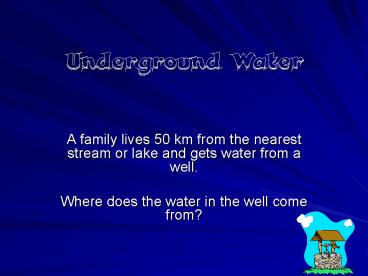Underground Water - PowerPoint PPT Presentation
1 / 28
Title:
Underground Water
Description:
Underground Water. A family lives 50 km from the nearest stream or lake and gets ... Dripstone are deposits calcium carbonate (a type of limestone) that drips from a ... – PowerPoint PPT presentation
Number of Views:69
Avg rating:3.0/5.0
Title: Underground Water
1
Underground Water
- A family lives 50 km from the nearest stream or
lake and gets water from a well. - Where does the water in the well come from?
2
Ground water
- Water located within the rocks below the Earths
surface. - Is an important resource
- Plays an important role in erosion and deposition
3
Location of Ground Water
- Surface water seeps underground into the soil and
rock - 2 zones for underground water
- Zone of aeration
- Not completely filled with water
- Usually fills immediately after a rain
- Zone of saturation
- Further down
- Spaces between rock particles fills with water
4
Water Table
- The underground boundary of where the two zones
meet - Rises during wet seasons
- Drops during dry seasons
- Climate determines where the water table is
located - Wet regions just beneath the soils surface
- Dry regions may be 100 of meters underground
5
(No Transcript)
6
Falling Water Tables
- Sustainability ultimately depends on balancing
withdrawals with rates of recharge. - Major indicator that ground water withdrawals are
exceeding recharge is a falling water table
7
Aquifers
- A rock layer that stores and allows the flow of
ground water. - Some rocks hold more water than others
- Rock layers must be porous
- Porosity is the amount of space between
individual rock particles - Permeability is a rocks ability to let water
pass through it (a rock that stops the flow of
water is called impermeable)
8
(No Transcript)
9
Aquifer Geology and Geography
- Best aquifers are formed of sandstone, limestone,
or layers of sand and gravel - Some cover large areas
- Some are important water supplies for cities and
agriculture.
10
Washington Aquifers
11
Is That a fact!
- Geologists estimate that aquifers hold 50 million
cubic kilometers of water worldwide. There is
about 20 times more water underground than in all
the rivers, lakes, and the atmosphere.
12
How Much?
13
How Much ??
14
Recharge Zone
- The ground surface where water enters an aquifer
- Like rivers, aquifers, are dependant on the water
cycle to maintain a constant flow of water.
15
Tapping more ground water?
- More than 2 billion people already depend on
ground water! - Many areas groundwater use already exceeds
aquifer recharge what then? - Depleting groundwater is the single greatest
threat to irrigated agriculture what then?
16
Springs
- Ground water movement is determined by the slope
of the water table - A spring is when the water table reaches the
Earths surface (are important sources of
drinking water)
17
Artesian Spring
- Are springs that form where cracks occur
naturally in the cap rock and the pressurized
water in the aquifer flows through the cracks to
the surface
18
Wells
- Is a human-made hole that is deeper than the
level of the water table - If the water table falls below the bottom of the
well it will dry up
19
Water in developing worlds
- In many villages and cities of the developing
world, people withdraw water from rivers,
streams, and ponds. These sources are often
contaminated with pathogens (bacteria) and other
pollutants.
20
Cave Formations
- Forms when water dissolve and erodes certain
types of rock under the ground - Usually limestone (calcium carbonate)
- Dripstone are deposits calcium carbonate (a type
of limestone) that drips from a crack in a caves
ceiling
21
Stalagmites
22
Stalactites
23
Environmental Connection
- Most bat species live in caves. These
night-flying mammals navigate by sound and can
reach speeds of 95 km/h. Today scientists know
that bats play an extremely important role in the
environment. Bats are great consumers of
insects, and many bat species pollinate plants
and distribute seeds.
24
Sinkholes
- Occurs when the roof of a cave collapses
- When the water table is lower than the level of
the cave, the cave is no longer supported by the
water underneath
25
(No Transcript)
26
(No Transcript)
27
Daily Assignment
- Review questions pg 284 1-4
- Explain how sink holes and caves form as a result
of erosion. - Concept map (zone of aeration, zone of
saturation, water table, porosity, permeability,
impermeable, confined aquifer, artesian spring,
spring)
28
Brain Food
- Much of Australias ground water is stored in
artesian formations, such as those fed by a vast
underground rock formation called the Great
Artesian Basin. Unfortunately, most of the water
is too salty for people to drink or use for
irrigation.































